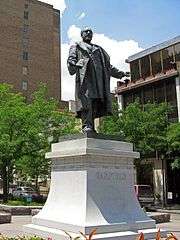Piatt Park
Piatt Park (est. 1817), is the oldest park in Cincinnati, Ohio. The urban park stretches two blocks between Elm Street and Vine Street on Garfield Place/8th Street. The park is owned and maintained by the Cincinnati Park Board.

History
In 1817 John H. Piatt, a steamboat builder,[1] and his brother, Benjamin M. Piatt, a Federal Circuit Judge and father of Civil War general Abram S. Piatt, gave 1 acre (0.40 ha) to the city on the condition it be used "for a market space".[2][3] Its close proximity to the Sixth Street Market probably prevented the carrying out of the original wishes of the donors, and on June 19, 1868, the land along Eighth Street was formally dedicated to park uses.[4][5]
Bronze statues of US Presidents from Ohio stand on either end of the park, with a sculpture of James A. Garfield facing Vine and one of William Henry Harrison facing West toward the Covenant First Presbyterian Church across Elm.[6]
The Garfield statue, by Charles Henry Niehaus, was commissioned in 1883 and unveiled in 1887. Due to the presence of the statue of Garfield, the city park was known for a time as Garfield Park, officially receiving its designation as Piatt Park by the Board of Park Commissioners in 1940.[2] The James A. Garfield statue was originally at the center of the street crossing of Garfield Place and Race Street. In 1915 it was moved into the park close to the same intersection. It was again moved during the renovation of Piatt Park in 1988 and now stands at the Vine Street entrance to the park.[7] In 1994 the statue was vandalized with a painted anarchy symbol which seeped into the stone pedestal and is still somewhat visible.[8]
The bronze equestrian statue of a uniformed General Harrison on horseback by Louis T. Rebisso of the Cincinnati School of Design and his student Clement Barnhorn was dedicated in 1896. The North side of the pedestal states "Ohio's First President" and the South side has his name "William Henry Harrison". The statue is odd in that there is no saddle on the horse so the stirrups seem airborne. It is notable for being the only equestrian monument in Cincinnati. The monument originally faced East toward Vine Street but was moved in 1988 to its present location.[6]
Flanking Race Street in Piatt Park are two circular reflecting pools with granite slabs that mirror the surrounding urban landscape. Beneath a curtain of water that flows over the granite surfaces are carved symbols for water, air and land. Cincinnati artist Stuart Fink’s fountain was dedicated in 1989 in memory of local delicatessen owner Isadore “Izzy” Kadetz, who died in 1983.[9]
Gallery
 The Garfield Monument in winter.
The Garfield Monument in winter. The Garfield Monument in summer.
The Garfield Monument in summer.
 Inside the shade trees.
Inside the shade trees. Piatt Park in Winter facing Vine.
Piatt Park in Winter facing Vine. Vintage stereoscopic view of the park
Vintage stereoscopic view of the park
See also
- Lytle Park
References
| Wikimedia Commons has media related to Piatt Park. |
- Rolfes, Steven (Oct 29, 2012). Cincinnati Landmarks. Arcadia Publishing. p. 25. Retrieved 2013-05-19.
- Older, archived website of the Cincinnati Parks Board
- Stradling, David (Oct 1, 2003). Cincinnati: From River City to Highway Metropolis. Arcadia Publishing. p. 36. Retrieved 2013-05-25.
- Industrial Bureau of Cincinnati (1909). The Cincinnati Industrial Magazine, Volumes 1-2. p. 79. Retrieved 2013-05-20.
- Nancy A. Recchie & Jeffrey T. Darbee (Oct 6, 2010). Cincinnati Parks and Parkways. Arcadia Publishing. p. 9. Retrieved 2013-05-08.
- "Statue of William Henry Harrison - Cincinnati, Ohio - American Guide Series on Waymarking.com". www.waymarking.com. Retrieved 2016-10-11.
- "Statue of James A. Garfield - Cincinnati, Ohio - American Guide Series on Waymarking.com". www.waymarking.com. Retrieved 2016-10-11.
- Jones, Kent; et al. (Jul 18, 2011). Historic Downtown Cincinnati. Arcadia Publishing. p. 48. Retrieved 2013-05-04.
- "Piatt Park - Cincinnati Parks". Cincinnati Parks. Retrieved 2016-10-11.